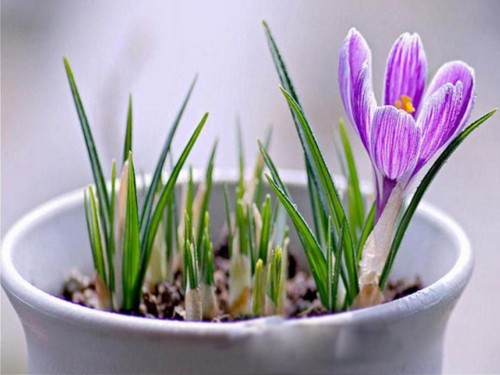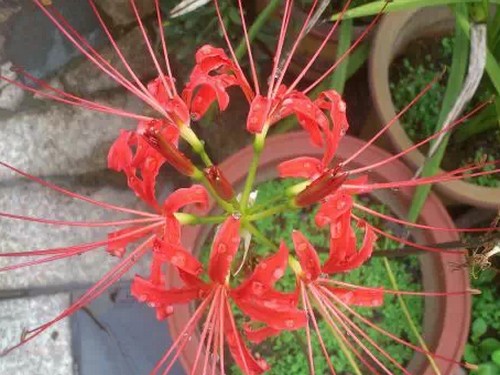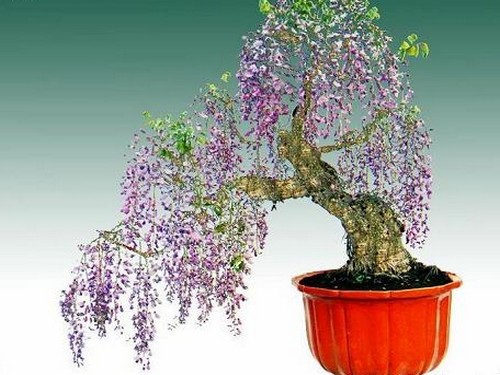Planting techniques of potted saffron
Saffron, also known as saffron, saffron, belongs to the Iridaceae perennial herb, about 15 cm high, the bulb oblate, the outer layer of brown membranous scales. The leaf is long linear, the leaf vein is white, the leaf margin is slightly curled; there are 6 petals, purple color, 3 stamens, 1 pistil, 3 styles, the style protrudes from the perianth, showing dark red, and the front end of the stigma is slightly expanded in the shape of a trumpet, with a strong fragrance. Although saffron blossoms, it does not bear fruit. Saffron propagates asexually through bulbs.

The methods of breeding bulbs in the field and picking flowers indoors are mostly used in our country. The effective components of the filaments are high and the quality is excellent. Saffron can be cultivated in most areas.
1. Seed selection and corm storage of saffron.
Saffron is a triploid, which only blossoms but does not bear seeds and is propagated by bulbs. The bulbs should be purchased from June to September for the first time. Bulbs with intact, disease-free and robust bulbs with a weight of more than 10 grams should be selected. Bulbs less than 8 grams can not blossom in the same year. Smaller bulbs need to be planted continuously for 2 to 3 years before they can blossom. The saffron beauty salon on Taobao has bulbs for sale.
The saffron which has been cultivated for a year, after the leaves on the ground withered completely from May to June, choose a suitable sunny day to dig out the corm, and be careful not to damage the corm. The dug-out bulbs should be spread out to dry, and after drying, the branches and leaves should be cut off to screen out the damaged and diseased corms. Separate the healthy, disease-free and intact bulbs according to size and store them in a ventilated, dry, cool room with little light until September. Crocuses can also spend the summer in the soil without digging, but what to do is not recommended because it is more prone to rot and insect pests in the soil.
2. Saffron planting
Saffron corms can be treated with chemicals before planting, which can effectively control diseases. The main disease of saffron is rot. The bulbs are usually soaked in a 500-fold solution of 25% carbendazim for 20 minutes before planting.
Saffron should be potted in September, choose a flowerpot with a diameter of about 15 cm, with 5-6 bulbs per pot. The cultivation medium should be cultivated with loose, fertile and well-drained soil, or mixed with moss peat and sandy loam, and applied with mature organic fertilizer plus a small amount of nitrogen, phosphorus and potassium compound fertilizer. The planting depth of saffron corm is 5-6 cm. Water the roots once after planting to keep the soil moist, and about ten days later the bulbs begin to take root and sprout.
3. Pot planting management of saffron.
Saffron grows in flowerpots from September to June of the following year, about 9 months. Flowering once during this period, flowering in winter (late October to early November) or early spring (January to February), flowering 15-20 days. During this period, we should do a good job in the following six aspects.
Temperature: although saffron is a cold-tolerant crop, it can withstand the low temperature of-18 ℃, but the low temperature is disadvantageous to its growth, and the severe cold is vulnerable to frost injury, so the saffron should be placed in a place with sufficient indoor light in winter, and the temperature should be kept above 5 ℃. In April and May of the following year, when the temperature rises above 20 ℃, the saffron should be moved to a shady place to prolong the growth time of the saffron corm so as to obtain a larger corm.
Watering: crocuses should be watered to keep the soil moist after planting. Pay attention to drainage on rainy days to prevent crocuses from being waterlogged. Usually use foliar spray to replenish water for saffron.
Fertilization: apply sufficient base fertilizer before planting crocuses. After leaf spreading, diluted organic fertilizer or 1% nitrogen, phosphorus and potassium compound fertilizer was applied every 20 days or so. In order to make the saffron leaves more green and vigorous, the flowers more colorful and the bulbs more robust, potassium dihydrogen phosphate foliar fertilizer can be sprayed every 15 to 20 days after leaf expansion.
Pest control: the temperature of the whole growing period of saffron is lower, and there are fewer diseases and insect pests. In March, saffron entered the new bulb growth period, the use of carbendazim spraying roots can effectively control rot. If aphids appear on the leaves, dimethoate can be used to control them.
Time: 2019-05-25 Click:
- Prev

How to plant the flowers on the other side
For a long time, the Chinese decorative style is mainly to advocate solemnity and elegance, pay attention to the beauty of symmetry. In terms of color, red and black are the most, these two colors make people feel strong and mature, full of connotation. The red other shore flower has a special flavor at home.
- Next

How do you grow wisteria? Wisteria planting method
Wisteria is a large woody deciduous vine of the genus Wisteria in Leguminosae. The stems are tangled, the branches and leaves are dense, the purple ear hangs in early summer, the flowers are numerous and fragrant, the leaves are full of leaves and the pods are numerous in the heat of summer, it is an excellent ornamental vine. It can be propagated by sowing, cutting, grafting, striping, dividing plants and so on.
Related
- Fuxing push coffee new agricultural production and marketing class: lack of small-scale processing plants
- Jujube rice field leisure farm deep ploughing Yilan for five years to create a space for organic food and play
- Nongyu Farm-A trial of organic papaya for brave women with advanced technology
- Four points for attention in the prevention and control of diseases and insect pests of edible fungi
- How to add nutrient solution to Edible Fungi
- Is there any good way to control edible fungus mites?
- Open Inoculation Technology of Edible Fungi
- Is there any clever way to use fertilizer for edible fungus in winter?
- What agents are used to kill the pathogens of edible fungi in the mushroom shed?
- Rapid drying of Edible Fungi

